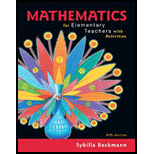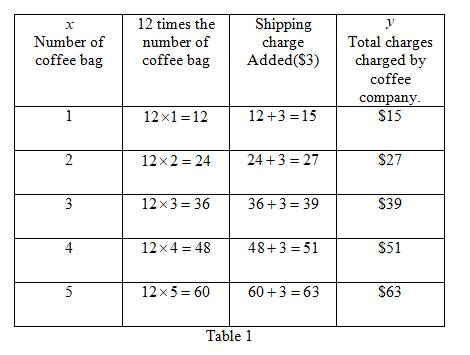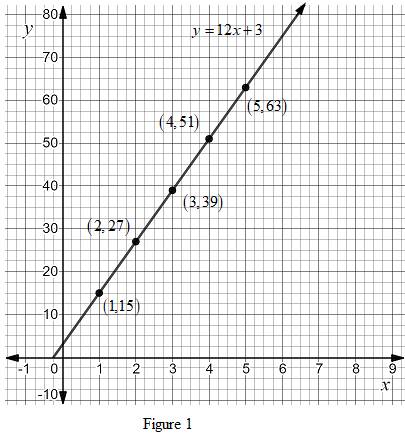
A small-order coffee company charges $12 for each bag of coffee plus $3 shipping no matter how many bags are ordered. Describe a function that this situation gives rise to. Make a table for this function, sketch a graph of this function, and fund an equation for this function. Is the function linear or not? How can you tell?
To find: The function, make table for the function, sketch a graph of the function, also find the equation of function and also check whether the function is linear or not.
Answer to Problem 1P
The equation of the function is
Explanation of Solution
Given information:
The cost of each bag of coffee plus is $12 and $3 shipping charges no matter how many bags are order.
Calculation:
The above problem gives rise to a coffee bag function.
The input of the function is the number of bags of coffee ordered and output of the function is charges charged by the coffee company.
Consider
The table represent the given coffee bag function as shown in Table 1

The number of coffee bags ordered is represented on
The point obtained from the Table 1 marked on the coordinate and join them.
The graph represented the given coffee bag function is shown in Figure 1.

It is observed from the Figure 1 that the total charges charge by the company is the sum of cost of each coffee bag
Therefore, the equation of the given coffee bag function can be obtained as,
The above equation is linear function because the graph of linear function is a line.
Therefore, the equation of the function
Conclusion:
Thus, the equation of the function is
Want to see more full solutions like this?
Chapter 9 Solutions
Pearson eText for Mathematics for Elementary Teachers with Activities -- Instant Access (Pearson+)
Additional Math Textbook Solutions
A First Course in Probability (10th Edition)
Elementary Statistics: Picturing the World (7th Edition)
A Problem Solving Approach To Mathematics For Elementary School Teachers (13th Edition)
Thinking Mathematically (6th Edition)
Pre-Algebra Student Edition
Basic Business Statistics, Student Value Edition
- 2PM Tue Mar 4 7 Dashboard Calendar To Do Notifications Inbox File Details a 25/SP-CIT-105-02 Statics for Technicians Q-7 Determine the resultant of the load system shown. Locate where the resultant intersects grade with respect to point A at the base of the structure. 40 N/m 2 m 1.5 m 50 N 100 N/m Fig.- Problem-7 4 m Gradearrow_forwardif δ ≥ 2, then it contains a cycle with length at least δ + 1.arrow_forward+6x²+135x+1) (0≤x≤10). a) Find the number of units The total profit P(x) (in thousands of dollars) from a sale of x thousand units of a new product is given by P(x) = In (-x²+6x² + 135x+ that should be sold in order to maximize the total profit. b) What is the maximum profit?arrow_forward
- 7. Find the doubling time of an investment earning 2.5% interest compounded a) semiannually b) continuouslyarrow_forward6. Find the time it will take $1000 to grow to $5000 at an interest rate of 3.5% if the interest is compounded a) quarterly b) continuouslyarrow_forwardA smallish urn contains 16 small plastic bunnies - 9 of which are pink and 7 of which are white. 10 bunnies are drawn from the urn at random with replacement, and X is the number of pink bunnies that are drawn. (a) P(X=6)[Select] (b) P(X>7) ≈ [Select]arrow_forward
- . Find how many years it takes for $1786 to grow to $2063 if invested at 2.6% annual interest compounded monthly. 12+arrow_forwardK=3, Gauss Seidel Fill in only 4 decimal places here in Canvas. Make sure in exam and homework, 6 decimal places are required. X1 = X2 = X3 =arrow_forwardA smallish urn contains 25 small plastic bunnies - 7 of which are pink and 18 of which are white. 10 bunnies are drawn from the urn at random with replacement, and X is the number of pink bunnies that are drawn. (a) P(X = 5)=[Select] (b) P(X<6) [Select]arrow_forward
 College Algebra (MindTap Course List)AlgebraISBN:9781305652231Author:R. David Gustafson, Jeff HughesPublisher:Cengage Learning
College Algebra (MindTap Course List)AlgebraISBN:9781305652231Author:R. David Gustafson, Jeff HughesPublisher:Cengage Learning
 Intermediate AlgebraAlgebraISBN:9781285195728Author:Jerome E. Kaufmann, Karen L. SchwittersPublisher:Cengage Learning
Intermediate AlgebraAlgebraISBN:9781285195728Author:Jerome E. Kaufmann, Karen L. SchwittersPublisher:Cengage Learning Algebra: Structure And Method, Book 1AlgebraISBN:9780395977224Author:Richard G. Brown, Mary P. Dolciani, Robert H. Sorgenfrey, William L. ColePublisher:McDougal Littell
Algebra: Structure And Method, Book 1AlgebraISBN:9780395977224Author:Richard G. Brown, Mary P. Dolciani, Robert H. Sorgenfrey, William L. ColePublisher:McDougal Littell Glencoe Algebra 1, Student Edition, 9780079039897...AlgebraISBN:9780079039897Author:CarterPublisher:McGraw Hill
Glencoe Algebra 1, Student Edition, 9780079039897...AlgebraISBN:9780079039897Author:CarterPublisher:McGraw Hill





